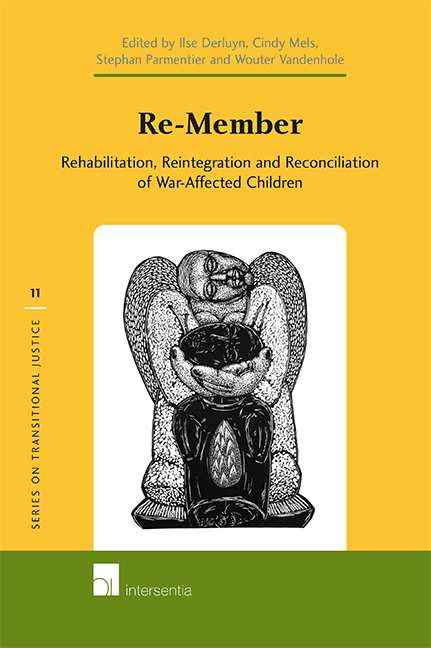Book contents
- Frontmatter
- Preface
- Foreword
- Contents
- Introduction: Children Affected by Armed Conflict at the Intersection of Three Fields of Study
- PART I SETTING THE SCENE: THREE DISCIPLINARY PERSPECTIVES
- PART II LESSONS LEARNT FROM CURRENT PRACTICES AND APPROACHES
- PART III EXPLORING RESOURCES THROUGH EMPIRICAL RESEARCH
- PART IV LOOKING BACK, REACHING FORWARD
- About the Editors
- About the Authors
14 - Psychosocial Care in Rehabilitation Centres for Former Child Soldiers in Northern Uganda
Published online by Cambridge University Press: 20 January 2021
- Frontmatter
- Preface
- Foreword
- Contents
- Introduction: Children Affected by Armed Conflict at the Intersection of Three Fields of Study
- PART I SETTING THE SCENE: THREE DISCIPLINARY PERSPECTIVES
- PART II LESSONS LEARNT FROM CURRENT PRACTICES AND APPROACHES
- PART III EXPLORING RESOURCES THROUGH EMPIRICAL RESEARCH
- PART IV LOOKING BACK, REACHING FORWARD
- About the Editors
- About the Authors
Summary
INTRODUCTION
This chapter aims to outline an overview of psychosocial caretaking activities organised by rehabilitation centres (RCs) for former child soldiers in northern Uganda. The conflict in northern Uganda is sometimes referred to as ‘one of the most forgotten conflicts in the world’ or ‘one of the worst violations of children's rights anywhere in the world’. For over 20 years this country has suffered from a cruel and bloody war between the government army (Ugandan People's Defence Force, UPDF) and the Lord's Resistance Army (LRA), a rebel group under the command of Joseph Kony. The LRA had a tremendous impact on daily life as it concentrated its terror on the civilian population by looting and attacking villages, burning houses, and, worst of all, by mutilating, killing and abducting children and adults. It is estimated that over the course of the conflict, Kony and his army were responsible for the deaths of about one million people, while nearly two million people were forced to live in camps for internally displaced persons (IDP) for several years.
The abduction or use of children for the purpose of forced conscription and sexual exploitation is even today an important problem, as it is estimated that between 250,000 and 300,000 children are deployed as child soldiers in 17 conflicts worldwide. Northern Uganda had its share, with estimations ranging from 24,000 to 38,000 children to as many as 66,000 children and young adults between 14 and 30 years old. Even more striking, Annan et al. found that more than one third of male youths and one fift h of female youths questioned in their study reported being abducted. Once abducted by the LRA, children were confronted with very difficult living conditions and without doubt life became a true struggle for survival. It started at the moment of abduction, when many children were tied, beaten and/or given heavy loads to carry.
- Type
- Chapter
- Information
- Re-MemberRehabilitation, Reintegration and Reconciliation of War-Affected Children, pp. 329 - 362Publisher: IntersentiaPrint publication year: 2012
- 4
- Cited by



